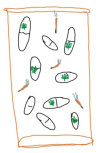The Endocannabinoid System
The endocannabinoid system is a regulatory system in our bodies that has effects on many functions such as mood, pain, learning and memory, inflammatory response, and eating. There has also been evidence that the endocannabinoid system plays a neuroprotective role following injury (1).
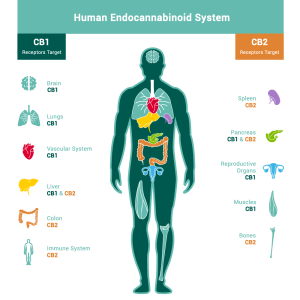
There has been a lot of interest lately in the utilization of this system as a therapeutic target for many diseases. Drugs that act on the endocannabinoid system to increase appetite and to help treat seizures caused by epilepsy have been approved, and utilize both CBD and THC to do so.
Endocannabinoids
Our bodies naturally produce molecules that activate this system, called endocannabinoids. These molecules are produced on-demand in response to the state our body is in. The receptors endocannabinoids act on are two types of CB receptors.
-
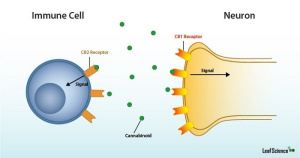
Difference between CB1 and CB2 receptors CB1 receptors are primarily found in the central nervous system, and are mainly on presynaptic neurons.
- CB2 receptors are found commonly on cells and tissues in the immune system, and are mainly activated in response to inflammation.
There are also exogenous materials that will act on the endocannabinoid system. Most commonly known and used are cannabis and THC.
Cannabis and THC
While you may have heard the terms marijuana and cannabis used interchangeable there are different meanings to each. The word ‘cannabis’ refers to all products derived from the plant Cannabis sativa. ‘Marijuana” refers to parts or products from the Cannabis sativa plant that contain a significant amount of tetrahydrocannabinol (THC).
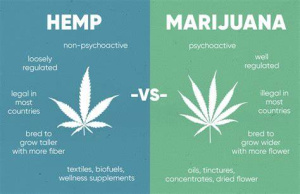
All natural (non-synthetic) marijuana is cannabis, but not all cannabis is marijuana. Hemp is the term used for cannabis compounds that contain less than .3% of THC or less (2).
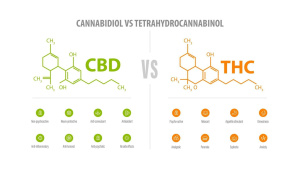
- THC: the main psychoactive molecule found in cannabis plants. This is the molecule that produces the ‘high’ sensation.
- CBD: cannabidiol is a molecule found in cannabis and is an activator of the endocannabinoid system. This molecule however doesn’t give the high that THC does.
Throughout the 1900s it became illegal in most of the world to grow cannabis plants for sale or personal use. But why?
Drug Scheduling in the US
To talk about the illegality of cannabis and THC, we need to have some basic understanding of how drug classification works in the United States. Under the Controlled Substances Act the government allowed the Drug Enforcement Administration (DEA) to classify drugs into 5 categories depending on the drugs accepted medical uses and it’s potential for abuse and addiction.
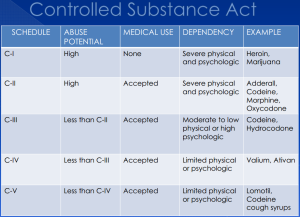
The higher the schedule, the more potential for abuse and addiction. Schedule 1 drugs are substances or chemicals that are defined as “drugs with no currently accepted medical use and a high potential for abuse” (3). Examples include LSD, ecstasy, and marijuana.
Woah wait! Why is marijuana included in that list when we already mentioned drugs that use THC? That’s where it gets tricky.
Medical Uses for CBD and THC
It’s commonly known that THC can induce hunger, or ‘the muchies’. Dronabinol is a capsule form of synthetic THC that is used as an appetite stimulant. It was approved in 1985 by the FDA, and was classified as a schedule 2 medication. However in 1991 it was rescheduled to schedule 3 based on evidence that it has low potential for abuse (4). So how is THC as dronabinol considered less addictive than the THC in marijuana? There has been lots of push to reschedule cannabis and marijuana down from schedule 1 based on this.
Benefits to Rescheduling Cannabis
THC is an approved an appetite stimulant medication and is often given to people undergoing chemotherapy to combat weight loss. However recently there has been research on the potential effects that THC can have for obstructive sleep apnea, chronic neuropathic pain, glaucoma, arthritis, and many others (5). CBD has recently been a topic of interest for the treatment of seizures, inflammation, migraines, and psychosis and other mental disorders (6).
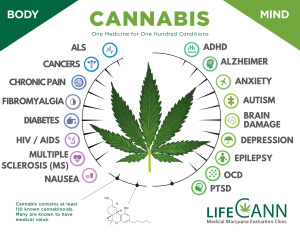
Cannabis being a schedule 1 drug makes further research into the use of THC to treat these conditions rather difficult, requiring lengthy petitions and government approval. Rescheduling cannabis into a lower drug class would make researching and developing medications involving THC and CBD an easier process.
References:
-
https://www.health.harvard.edu/blog/the-endocannabinoid-system-essential-and-mysterious-202108112569
-
https://www.nccih.nih.gov/health/cannabis-marijuana-and-cannabinoids-what-you-need-to-know
-
https://www.dea.gov/drug-information/drug-scheduling
-
https://www.pharmacytimes.com/view/dea-denial-of-petition-to-reschedule-marijuana
-
https://www.ncbi.nlm.nih.gov/books/NBK563174/
-
https://www.ncbi.nlm.nih.gov/pmc/articles/PMC6966847/
